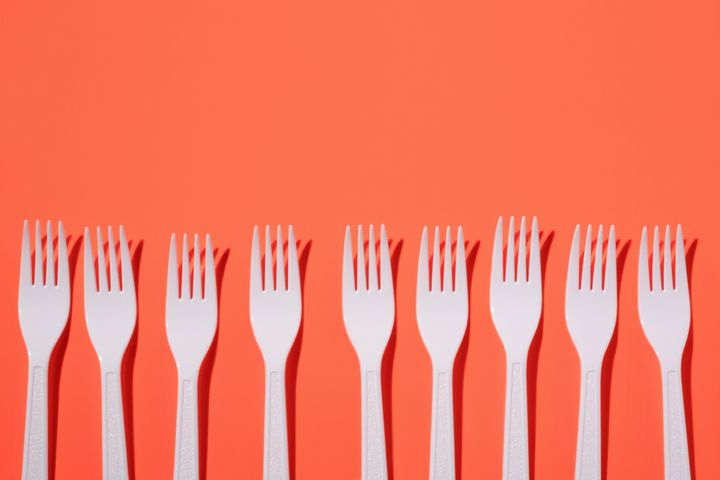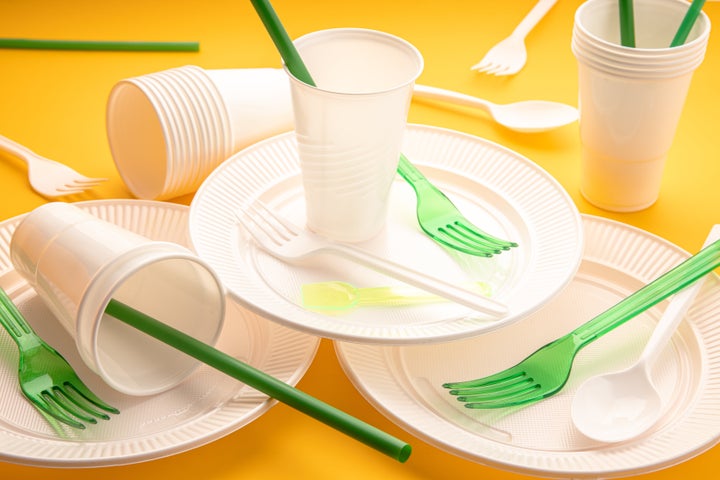
Feel like getting takeout instead of making a meal? Whether you want a treat for lunch or aren’t in the mood to make dinner (or, let’s be real, you never shopped for groceries and have no food in your fridge), you decide to order takeout. Some of the takeout containers or paper bags will be recyclable, as long as they’re not coated in any food residue or liquids. But there’s an item you should avoid if you want to lower your carbon footprint and reduce unnecessary plastic likely ending up in a landfill. That’s plastic cutlery.
That’s right: Plastic forks, knives and spoons may be made with recyclable plastic, but that doesn’t mean they actually can or will be recycled.
Wait, what?
We spoke to recycling experts to get to the plastic nitty-gritty on this nuanced topic.
There are different types of plastic used to make utensils, and they’re not all recycled.
“Virtually all plastics are recyclable, and that includes plastic cutlery,” said Louis Vetrone, deputy commissioner for Westchester County Department of Environmental Facilities in New York. And yet there isn’t a uniform type of plastic used to make single-use utensils.
There are multiple types of plastic, designated by different numbers, used for utensils, explained Jeremy Walters, spokesperson and sustainability ambassador for Republic Services, one of the United States’ largest waste management companies.
“Commonly it comes in the form of number six, which is polystyrene, but I’ve seen versions where it’s polypropylene [number five] and number seven, which could be a blend of all three of those,” Walters said. “There’s no consistent polymer that makes up the form of the knife, spoon or fork.” He said this is the first problem.
Some plastics are recyclable and others aren’t, but the type of plastic isn’t the real problem. “The characteristic of plastic cutlery is the bigger problem rather than the polymer that it’s made of,” Walters said.
As a person who wants to do their part, you toss all your recyclable plastics in your curbside recycling bin and then quickly forget about it. But the situation gets complicated quickly.
Recycling machines aren’t designed for plastic utensils.
Even if plastic is recyclable, that doesn’t mean a recycling centre is capable of processing the size of the plastic. “The caveat is what can the recycling plant handle? If it’s not set up for a particular plastic, it cannot be accepted in the stream in that area by its customers, whether it’s business or residential,” said Stacy Savage, founder and CEO of Zero Waste Strategies.
Many recycling plants are limited by what the machinery can process. In this case, the shape and the size of the utensils are why they can’t be recycled. “If you think about a knife, it’s pretty flat,” Walters said. Small and thin plastics can stop the machines. “It’s going to have a tendency to either jam between discs and then be improperly sorted because they’re not three-dimensional in the sense that a bottle is,” he added.
Plastic cutlery isn’t accepted in Westchester County, either, because its system can’t process it. “Our system, Material Recovery Facility (MRF) is pretty technologically savvy and we utilise optical sorters to sort out plastics,” Vetrone said. “A lot of the system is automated, but we also have picking crews that do a pre-sort and go through those materials.”
Despite advanced technology, optical sorters can’t detect the material, which can cause havoc. “Plastic cutlery either falls through openings in the equipment or they’ll get tangled up in the equipment, which is even worse because then we can have downtime,” Vetrone said. “We might have to shut down the equipment and fix the conveyors if they get jammed up in the gears.”
And one of the biggest recycling operators in the United States also can’t recycle utensils. “Plastic cutlery is not accepted in any [Waste Management[ curbside recycling programs,” said Brent Bell, the vice president of recycling at Waste Management.
So what happens to items that can’t be processed? That depends on the type of recycling facility, but almost all plastic utensils that go to recycling plants will end up in a landfill. The Westchester plant is an exception to the rule since they are one of thirty in the United States that is a waste-to-energy facility. According to Vetrone, “If it’s a jurisdiction that utilises landfill, they’ll be sent to the landfill, or for us, they’ll be sent to a waste-to-energy facility.”

Here’s what to say when ordering takeout.
Next time you order takeout, tell the restaurant to hold the plastic cutlery. It’s as simple as making a note on your order that you don’t need any single-use forks or knives. “When I call in and when I come to pick up my order, I say, ‘I don’t need any of the extra sauces. I don’t need the napkins. I don’t need the plastic cutlery,’” Walters said. “Make it known that you don’t need it.”
It may seem like a small step, but it’s one less item that will likely end up in the wrong place or the landfill. And if you’re ordering a meal to eat at home, you have silverware available, so receiving one-use plastic isn’t necessary and often unwanted.
With an avalanche of plastic in our lives, it can feel overwhelming to think that an individual can make much of a difference. But enough people refusing one-use items means less waste at the processing plant. “It’s small habit changes that make a big impact when we all try to do our best,” Walters said.
Should you bother recycling the plastic utensils you do have?
And if you’re wondering what to do with the collection of plastic cutlery piling up in your miscellaneous drawer, we asked the experts. You can always double-check if your municipality is able to process and recycle these types of plastics. “Call the recycling plant in your local area, your local hauler that processes your recyclables, or the city ― usually the Solid Waste Department or the utility department ― so that you can find out [if they take plastic cutlery]. But the vast majority of the time [they won’t] because of the weight and the size,” Savage advised.
Because most recycling plants can’t process plastic cutlery, the bad news is we’re left to toss it in the trash. “When in doubt, throw it out,” Savage said. She also recommended that customers contact plastic manufacturing companies about recycling options: “People can take action and call these companies that manufacture the plastics and say, ‘Why don’t you have take-back programs for cutlery?’”
Bring your own reusable cutlery.
You can always bring your own flatware to minimise using single-use plastic at activities like picnics and outdoor concerts. While not many people carry reusable flatware in their tote bags, it’s worth considering for those who often order food to go. “I don’t know anybody that walks around with stainless steel silverware,” Savage said. But considering she’s a sustainability advocate, she always has her own reusable utensils with her. “I do have a bamboo cutlery packet in my purse, and I bring that with me everywhere I go,” she said.
And everyone doing their part does add up. “People can make changes. There are alternatives,” Savage said. “It’s just about collective consciousness around refusing the materials that are polluting our planet and plastics are a big one.”
Reuse before you recycle.
There’s no doubt that recycling is important and needed to help the environment. But it’s a good idea to remember that recycling uses energy to process and break down material. “Recycling still requires some energy expenditure ― you need to truck the materials, it has to be collected curbside, delivered to a recycling centre or MRF,” Vetrone said. “And then it has to be processed, and then there’s energy expenditure for creating a new product out of it.”
He’s a proponent of reusing items as much as possible before relying on recycling materials. “The first line of defence is using reusable items,” Vetrone said. “If we use reusable water bottles, reusable coffee mugs, reusable utensils and straws, we’re not using the energy to mine virgin materials, or using that energy that’s needed to recycle [these] items as well.”